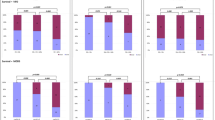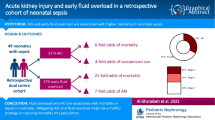Abstract
Background
Continuous renal replacement therapy (CRRT) has emerged as the modality of choice for the management of high-risk neonates with acute kidney injury (AKI), inborn errors of metabolism and multi-organ dysfunction. The aim of this study was to evaluate fluid overload (FO) and investigate the factors associated with outcomes in neonates undergoing CRRT.
Methods
We retrospectively reviewed the medical records of 34 neonates with AKI who were admitted to the neonatal intensive care unit (NICU) of Samsung Medical Center, Seoul, Republic of Korea between January 2007 and December 2014 where they underwent at least 24 h of CRRT.
Results
The survival rates of patients with an FO of ≥30 % at the time of CRRT initiation were lower than those of patients with an FO of <30 % at the same time-point. Univariate Cox regression analysis revealed that a higher percentage FO at CRRT initiation and decreased urine output at the end of CRRT were associated with mortality, and multivariate Cox regression analysis indicated that mortality was associated with decreased urine output at the end of CRRT. Univariate linear regression analysis revealed that the length of hospital stay was associated with higher levels of serum creatinine at CRRT initiation, longer stay in the NICU prior to initiation of CRRT, longer duration of CRRT and lower body weight at the time of NICU admission.
Conclusions
Neonates with a higher percentage FO and higher levels of serum creatinine at CRRT initiation showed poor outcomes. Early initiation of CRRT before the development of severe FO or azotemia might improve the outcomes of neonates requiring CRRT.

Similar content being viewed by others
References
Harshman LA, Muff-Luett M, Neuberger ML, Dagle JM, Shilyansky J, Nester CM, Brophy PD, Jetton JG (2014) Peritoneal dialysis in an extremely low-birth-weight infant with acute kidney injury. Clin Kidney J 7:582–585
Ponikvar R, Kandus A, Urbancic A, Kornhauser AG, Primozic J, Ponikvar JB (2002) Continuous renal replacement therapy and plasma exchange in newborns and infants. Artif Organs 26:163–168
Bonilla-Felix M (2009) Peritoneal dialysis in the pediatric intensive care unit setting. Perit Dial Int 29[Suppl 2]:S183–185
Teehan GS, Liangos O, Jaber BL (2003) Updated on dialytic management of acute renal failure. J Intensive Care Med 18:130–138
Westrope C, Morris K, Burford D, Morrison G (2010) Continuous hemofiltration in the control of neonatal hyperammonemia: a 10-year experience. Pediatr Nephrol 25:1725–1730
Hui WF, Chan WK, Lee KW (2012) Children on continuous renal replacement therapy: prognostic factors. Hong Kong Med J18:475–481
Ronco C, Bonello M, Bordoni V, Ricci Z, D’Intini V, Bellomo R, Levin NW (2004) Extracorporeal therapies in non-renal disease: treatment of sepsis and the peak concentration hypothesis. Blood Purif 22:164–174
Askenazi DJ, Goldstein SL, Koralkar R, Fortenberry J, Baum M, Hackbarth R, Blowey D, Bunchman TE, Brophy PD, Symons J, Chua A, Flores F, Somers MJ (2013) Continuous renal replacement therapy for children ≤10 kg: a report from the prospective pediatric continuous renal replacement therapy registry. J Pediatr 162:587–592
Foland JA, Fortenberry JD, Warshaw BL, Pettignano R, Merritt RK, Heard ML, Rogers K, Reid C, Tanner AJ, Easley KA (2004) Fluid overload before continuous hemofiltration and survival in critically ill children: A retrospective analysis. Crit Care Med 32:1771–1776
Arikan AA, Zappitelli M, Goldstein SL, Naipaul A, Jefferson LS, Loftis LL (2012) Fluid overload is associated with impaired oxygenation and morbidity in critically ill children. Pediatr Crit Care Med 13:253–258
Sutherland SM, Zappitelli M, Alexander SR, Chua AN, Brophy PD, Bunchman TE, Hackbarth R, Somers MJ, Baum M, Symons JM, Flores FX, Benfield M, Askenazi D, Chand D, Fortenberry JD, Mahan JD, McBryde K, Blowey D, Goldstein SL (2010) Fluid overload and mortality in children receiving continuous renal replacement therapy: The prospective pediatric continuous renal replacement therapy registry. Am J Kidney Dis 55:316–325
Hayes LW, Oster RA, Tofil NM, Tolwani AJ (2009) Outcomes of critically ill children requiring continuous renal replacement therapy. J Crit Care 24:394–400
Askenazi DJ, Koralkar R, Hundley HE, Montesanti A, Patil N, Ambalavanan N (2013) Fluid overload and mortality are associated with acute kidney injury in sick near-term/term neonate. Pediatr Nephrol 28:661–666
Koralkar R, Ambalavanan N, Levitan EB, McGwin G, Goldsterin S, Askenazi D (2011) Acute kidney injury reduces survival in very low birth weight infants. Pediatr Res 69:354–358
Bezerra CT, Vaz Cunha LC, Liborio AB (2013) Defining reduced urine output in neonatal ICU: importance for mortality and acute kidney classification. Nephrol Dial Transplant 28:901–909
Schwartz GJ, Brion LP, Spitzer A (1987) The use of plasma creatinine concentration for estimating glomerular filtration rate in infants, children, and adolescents. Pediatr Clin North Am 34:571–590
Selewski DT, Cornell TT, Lombel RM, Blatt NB, Han YY, Mottes T, Kommareddi M, Kershaw DB, Shanley TP, Heung M (2011) Weight-based determination of fluid overload status and mortality in pediatric intensive care unit patients requiring continuous renal replacement therapy. Intensive Care Med 37:1166–1173
Jung SH, Wieand S, Cha S (1995) A statistic for comparing two correlated markers, which are prognostic for time to event. Stat Med 14:2217–2226
Bagshaw SM, Brophy PD, Cruz D, Ronco C (2008) Fluid balance as a biomarker: impact of fluid overload on outcome in critically ill patients with acute kidney injury. Crit Care 12:169
Cotter G, Metra M, Milo-Cotter O, Dittrich HC, Gheorghiade M (2008) Fluid overload in acute heart failure-re-distribution and other mechanisms beyond fluid accumulation. Eur J Hear Fail 10:165–169
Cruz DN, Soni S, Slavin L, Ronco C, Maisel A (2010) Biomarkers of cardiac and kidney dysfunction in cardiorenal syndromes. Contrib Nephrol 165:83–92
Soni SS, Ronco C, Katz N, Cruz DN (2009) Early diagnosis of acute kidney injury: the promise of novel biomarkers. Blood Purif 28:165–174
Stein A, de Souza LV, Belettini CR, Menegazzo WR, Viégas JR, Costa Pereira EM, Eick R, Araújo L, Consolim-Colombo F, Irigoyen MC (2012) Fluid overload and changes in serum creatinine after cardiac surgery: predictors of mortality and longer intensive care stay. A prospective cohort study. Crit Care 16:R99
Wald R, Deshpande R, Bell CM, Bargman JM (2006) Survival to discharge among patients treated with continuous renal replacement therapy. Hemodial Int 10:82–87
Liangos O, Rao M, Balakrishnan VS, Pereira BJ, Jaber BL (2005) Relationship of urine output to dialysis initiation and mortality in acute renal failure. Nephron Clin Pract 99:c56–c60
Heise D, Gries D, Moeroer O, Bleckmann A, Quintel M (2012) Prediction of kidney function during CRRT-free intervals. J Cardiothorasc Surg 7:6
Morgan CJ, Zapitelli M, Robertson CM, Alton GY, Sauve RS, Joffe AR, Ross DB, Rebeyka IM, Western Canadian Complex Pediatric Therapies Follow-Up Group (2013) Risk factors for and outcomes of acute kidney injury neonates undergoing complex cardiac surgery. J Pediatr 162:120–127
Harnoll G, Bétrémieux P, Modi N (2000) Body water content of extremely preterm infants at birth. Arch Dis Child Fetal Neonatal Ed 83:F56–F59
Spinale JM, Laskin BL, Sondheimer N, Swartz SJ, Goldstein SL (2013) High-dose continuous renal replacement therapy for neonatal hyperammonemia. Pediatr Nephrol 28:983–986
Hanudel M, Avasare S, Tsai E, Yadin O, Zaritsky J (2014) A biphasic dialytic strategy for the treatment of neonatal hyperammonemia. Pediatr Nephrol 29:315–320
Acknowledgments
The authors would like to acknowledge the help of Sin-Ho Jung and Kiyoun Kim (Biostatistics and Clinical Epidemiology Center, Samsung Medical Center) for their support with statistical analysis.
Author information
Authors and Affiliations
Corresponding author
Ethics declarations
All data were obtained in accordance with the ethical principles for medical research involving human subjects established in the Helsinki Declaration of 1975 and revised in 2000. The Institutional Review Board of Samsung Medical Center approved this study.
Conflict of interest
The authors declare that they have no conflict of interest.
Rights and permissions
About this article
Cite this article
Lee, S.T., Cho, H. Fluid overload and outcomes in neonates receiving continuous renal replacement therapy. Pediatr Nephrol 31, 2145–2152 (2016). https://doi.org/10.1007/s00467-016-3363-z
Received:
Revised:
Accepted:
Published:
Issue Date:
DOI: https://doi.org/10.1007/s00467-016-3363-z




